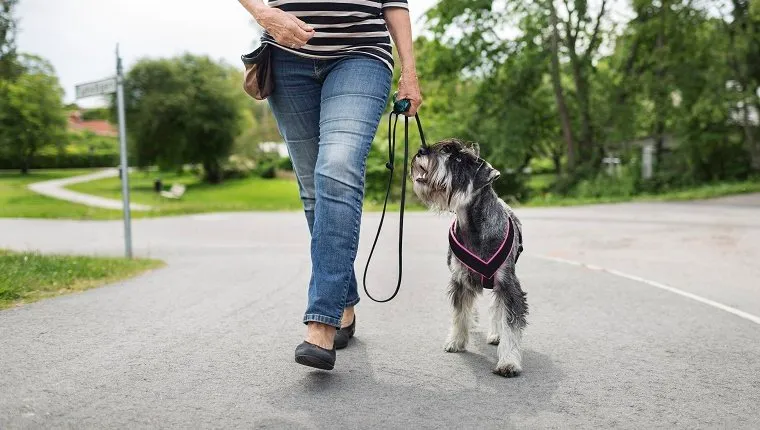[ad_1]
If you’ve been around dogs for a long time, you’ve probably walked a pooch who tugs pretty hard on the leash at some point.
They pull against the tension, sometimes choking themselves on their collar, and you might think that getting a harness will solve that problem.
You may be right, but there are important pros and cons to consider when deciding between using a collar or a harness.
Using A Collar

Collars are the usual solution when walking a dog. They come in a wide variety of styles.
Some are intentionally designed to constrict or cause discomfort when a dog pulls as a means of training, but we don’t recommend them as there are other training options that use positive reinforcement instead. Choke and prong collars fit into that category.

But a common, traditional collar that does not constrict is fine for dogs who don’t have respiratory problems and aren’t prone to pulling on leashes. They may also be more comfortable for some dogs, especially if you plan on leaving it on all the time.
A harness usually isn’t as comfortable for all day use. Also, if your dog has long hair, it might get caught up in a harness. A collar doesn’t have that problem.
However, for dogs who pull hard during walks, a collar can increase the risk of neck injury. A harness may be the better option in those cases.

There are also slip collars designed for pups who are prone to slipping out of traditional collars. These close around the neck when pooches pull or back up without choking, and they prevent dogs from getting loose.
Slip collars are especially effective for Greyhounds, Bulldogs, and other breeds who either have slim heads or thick necks.
Using A Harness

Harnesses are becoming more and more popular as dog parents discover the advantages they can offer. They’re great training tools for puppies learning to behave on leash, and they allow walkers to have a bit more control.
Harnesses discourage pulling and allow you to stop your dog from jumping up on strangers without worrying about choking. Dogs on harnesses are also less likely to be tangled up in the leash accidentally.

Another advantage harnesses have over collars is that they reduce the risk of neck injury, especially for delicate toy breeds. They also cause less restriction for breeds like Pugs and French Bulldogs who are prone to respiratory problems or tracheal collapse.
If your pup has any trouble breathing, a harness is likely the best choice. Collars can also cause certain breeds’ eyeballs to protrude from their sockets if too much pressure is applied to the neck.

Harnesses can either be front-attaching or back-attaching.
Front-attaching harnesses are effective for larger dogs as they lead from the front, while a back-attaching harness doesn’t allow for the walker to have as much control and may lead to worse pulling behavior since the dog does not feel the guidance necessary for training.
Back-attaching harnesses are recommended for small breeds as they’re more sensitive to pressure, and front-attaching harnesses can be painful for them.
Using Either Or Neither

When using a collar or a harness, it’s important that your dog is always wearing identification tags. Yes, that means all the time.
You never know when something can frighten or distract a dog and cause them to bolt, and you never know when your dog might accidentally get out of the house or off leash. Accidents happen. Microchips are important, but they aren’t the catch-all solution.
You should also research effective methods of training a dog on walking behavior. Pulling and jumping up are not ideal with either a collar or harness, and simply switching between the two won’t stop your dog from doing those things.

If your dog isn’t doing well with a collar or harness, there are other options like a head halter which wraps around the muzzle and head, though it’s not meant to curb barking or nipping by restricting mouth movement like a soft muzzle. It’s simply another option that offers a bit more control for a dog who’s easily distracted.
You should study how to use these effectively for training before purchasing one.
Do you use a harness, collar, or something else with your dog? Does your pooch have a preference?
[ad_2]
Source link








Leave a Comment